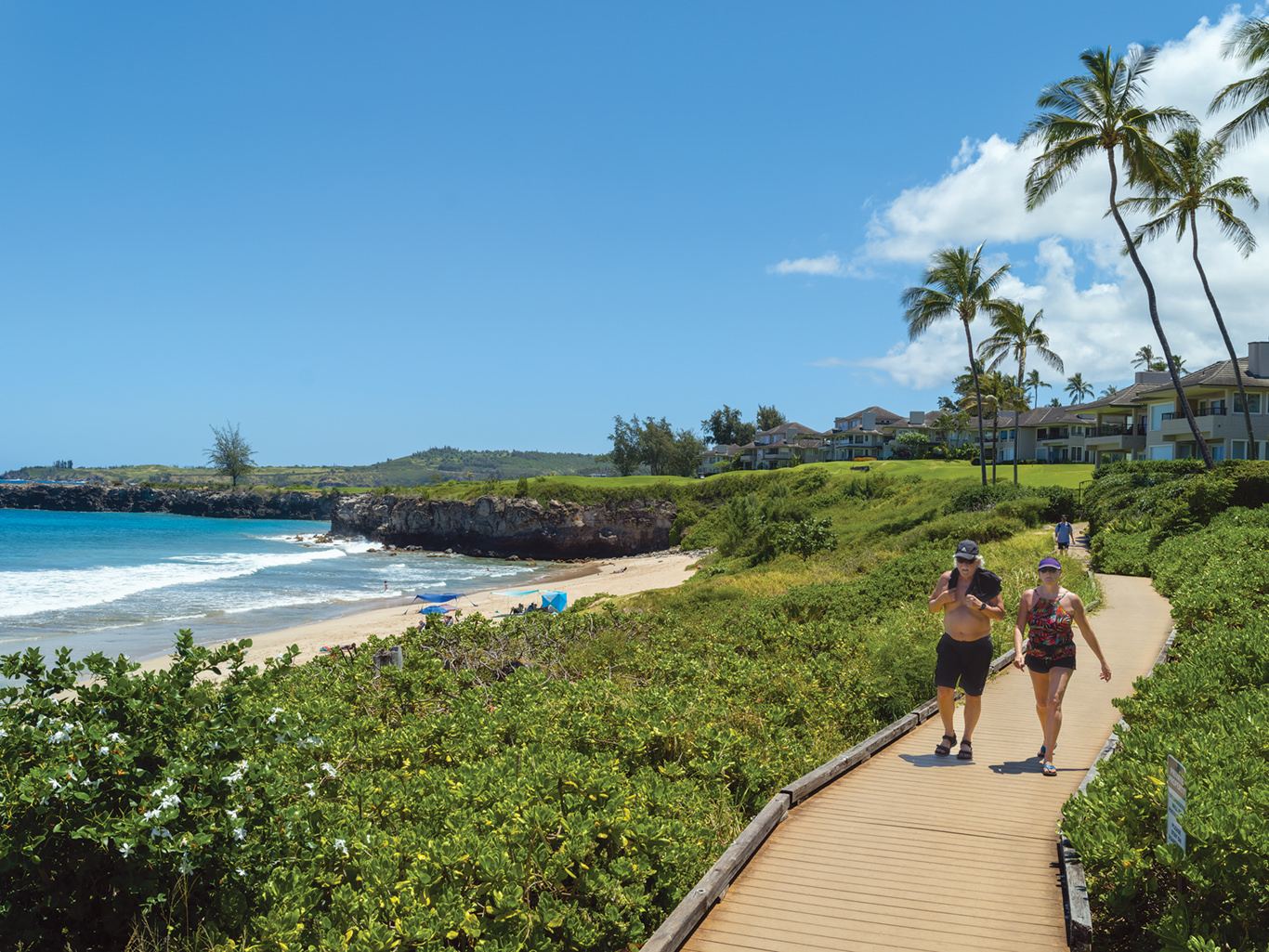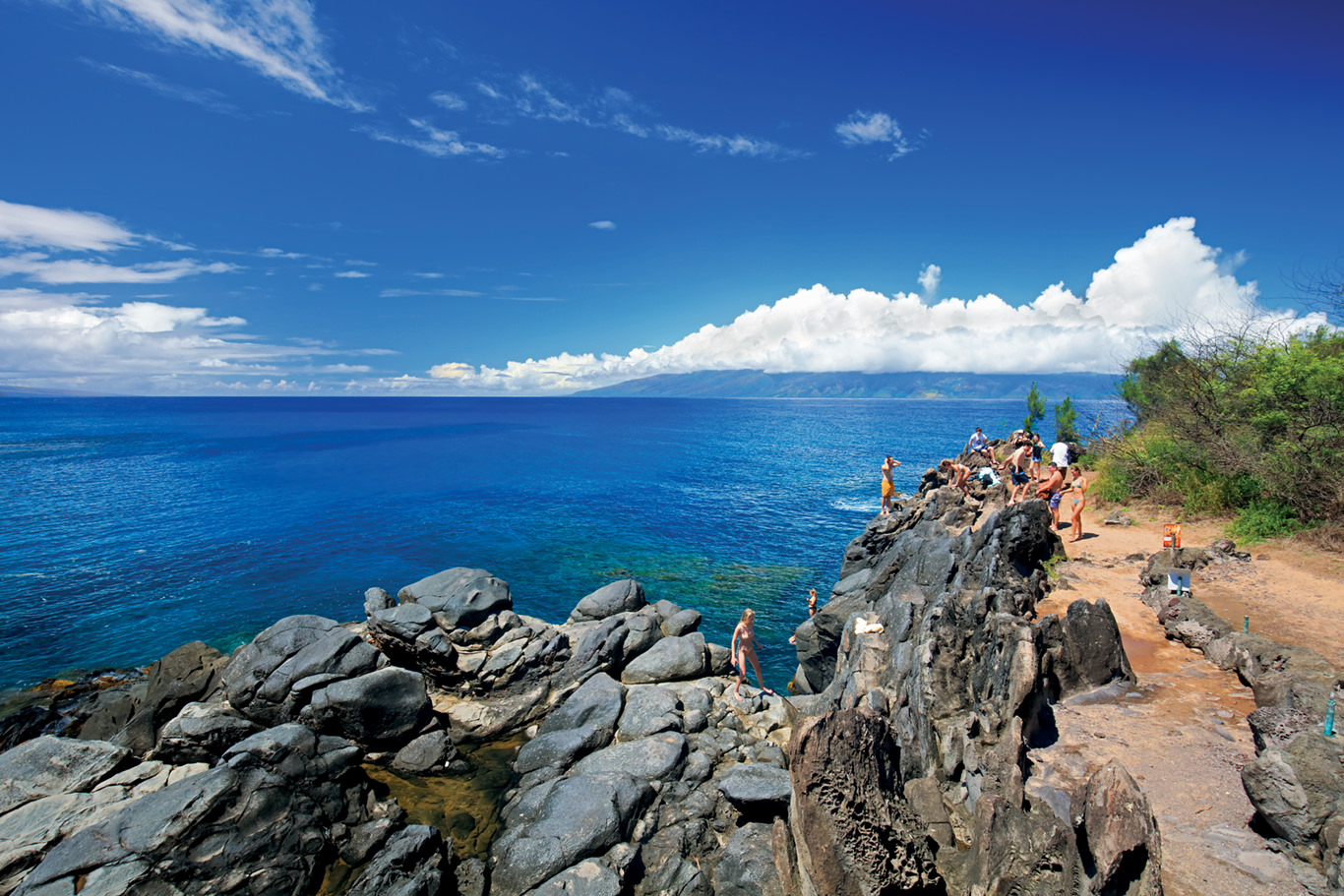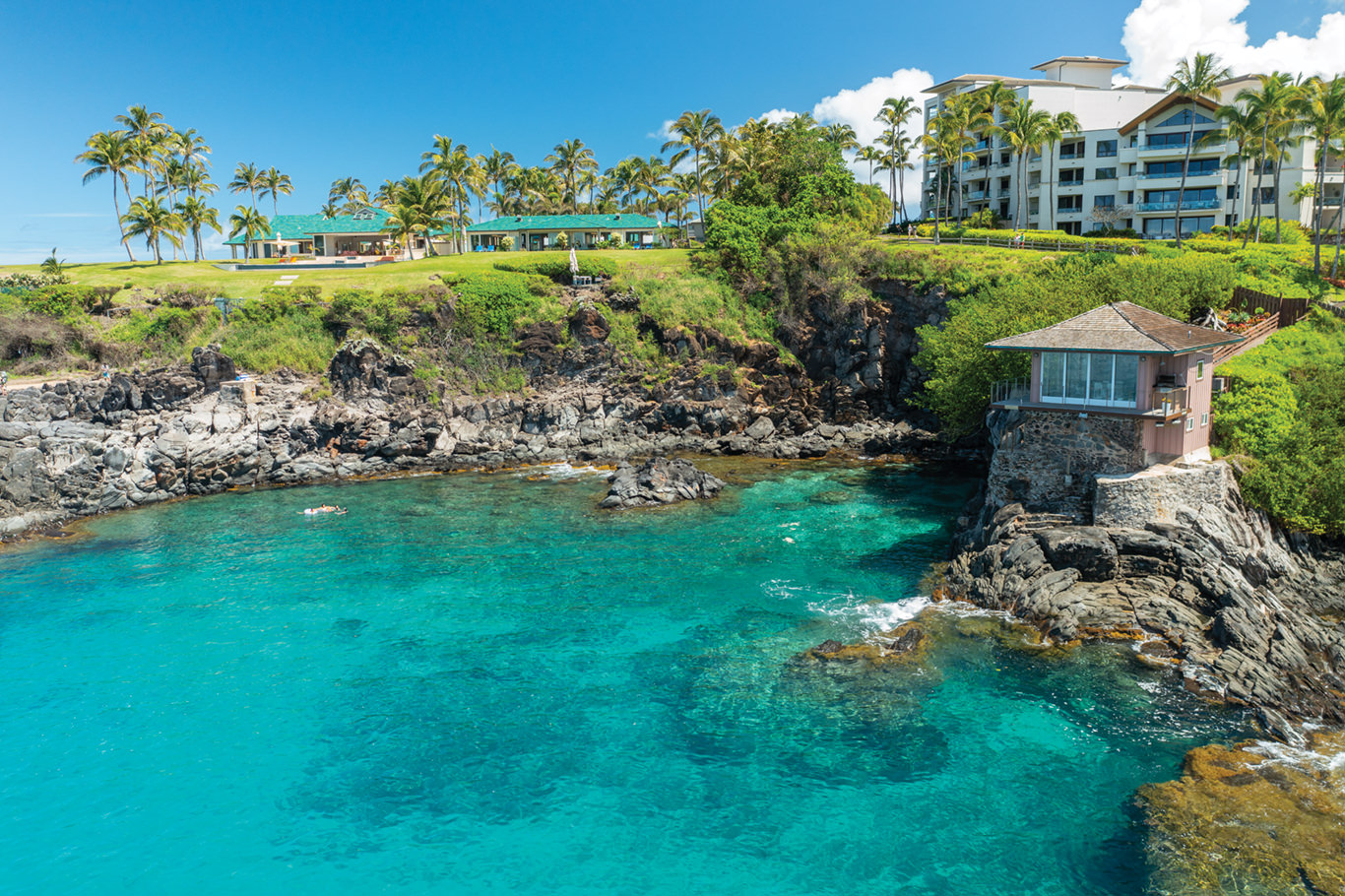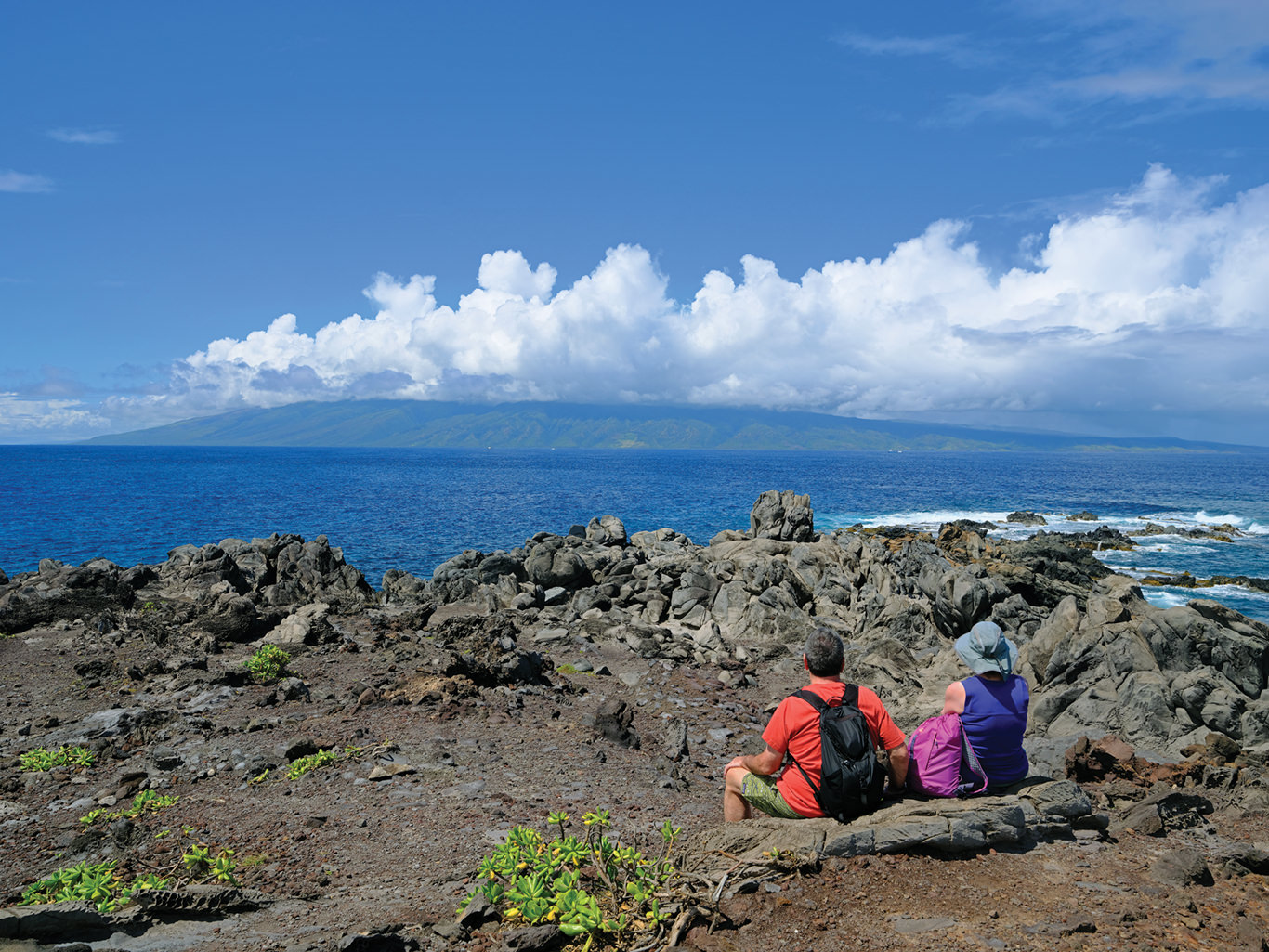Kapalua Coastal Trail
The 1.76-mile Kapalua Coastal Trail traces a coastline of warm-hued beaches and rugged lava points, where hikers can admire views of the island of Moloka‘i.
Story by Lisa Schell
Photographs by Jason Moore
With its wide sidewalks through luxury properties, the Kapalua Coastal Trail could be mistaken for simply a lovely resort amenity. But don’t let its proximity to Maui’s westside golf and tennis Mecca mislead. The 1.76-mile out-and-back trail gives easy access to some of Maui’s most stunning and rugged views. It also plays a vital role in protecting the island’s natural ecosystem and cultural history.
The Kapalua Coastal Trail cradles the coast between Kapalua Bay and Honokahua Bay. The trail opened in 2010 and is a large part of the Kapalua Resort’s commitment to conserving and protecting the West Maui coastline.
The Kapalua Bay trailhead is at a small tunnel that connects the trail to public parking at Bay Club Place off of Lower Honoapilani Road. Glare from sunlight and beach sand is blinding after the tunnel’s darkness. It feels like entering a tropical theme park – the lava rocks set against the turquoise and aquamarine ocean are too perfect to be real. It is tempting to stop, sit and spend the rest of the day here.

The view beyond the sand is compelling. At 9 miles to the northwest, neighbor Moloka‘i island seems close enough to touch. The desire to climb the short way up the hill wins out, if only to see what’s on the other side.
The top of this first gradual incline offers a complete view of the smaller Namalu Bay and The Cliff House, a 500-square-foot event venue nestled onto the cliffside at Montage Kapalua Bay resort. From this vantage, it is easy to spot swimmers in the water below the house.
The paved trail continues for 9 miles. Families carrying loads of gear to the beach scurry by. Runners jog past golfers coming in from a round. But then, a man wearing board shorts and soaking wet basketball shoes with fishing gear slung over his shoulder ambles by. Clearly, adventure must be ahead. In fact, it’s right across an access road, where the pavement gives way to dirt.
This is where the true magic of the Kapalua Coastal Trail begins. The resort setting gives way to a wide clifftop covered in low grass at Hāwea Point. Easily identifiable trails wind through the open space, inviting exploration of this two-acre conservation easement. The beachgoers are long gone. In their place are hikers with trekking poles and binoculars – people who look to be on a mission. The object of the mission: whales, sea birds, or both.
Hāwea Point offers a panoramic view of the Pailolo Channel that separates Maui and Moloka‘i. Humpback whales come to the islands between December and April to birth calves and breed. Even without binoculars, from the trail, it is easy to see spouts, breaches, and even a glimpse of a newborn calf. Joyful squeals from fellow hikers signal a whale sighting.
When the whales start to leave Maui Nui and head north, the ‘ua‘u kani, or wedge-tailed shearwater, return to land. Hāwea Point is part of a sprawling bird sanctuary designed to protect nesting ‘ua‘u kani.

These medium-sized, sooty-colored pelagic birds spend most of their life at sea. They return to terra firma in bonded pairs to nest one egg a year in ground burrows or cliff crevices. The Kapalua Coastal Trail skirts the edges of the nesting area with about 500 nesting pairs annually. Cordons protect the nesting habitat from accidental intrusion.
The ‘ua‘u kani is a culturally important species. Hawaiian voyagers watched for the ‘ua‘u kani to determine their distance from land. Fishermen also followed flocks of them in hopes of finding large schools of fish.
Three separate pathways lead beyond and around the nesting area. The one to the left leads to a light that warns mariners of the rocky point. From there, the trail becomes overgrown and can be muddy. Rocks hide beneath the tall grass. Eventually, the trail descends to a ledge, and the going might be tough and intimidating for some.
The path splits left and right. To the left lies the rocky platform that has been a literal jumping-off point for local cliff divers. To the right, the path leads to tidal pools recessed into the cliff. It’s a fascinating place to explore and can provide a respite from the sun and wind. Be mindful of tides and the ocean, though, as areas can be wet, slippery, and dangerous.
The only way out is back the way same way. Reconnecting with the main trail and staying to the left catapults hikers onto a lunar landscape. The ground is now jagged, sharp grey and black lava. The terrain is uneven, and the closer the trail comes to the cliff’s edge, the wetter it gets. The tip of Hāwea Point is the most remote, desolate, and exposed part of the hike. Waves crash against the cliffs. Salty spray lingers in the air and on the skin.
In prehistoric times, lava flows from the volcanic eruptions that created this end of Maui came to a violent halt here. The molten lava curled into petal or tooth-like shapes when it met the large ocean waves and cooled. The result is a garden of rock dinosaurs. Fans of all things Jurassic will have a field day trying to see how many shapes they can imagine in the lava.

Those same volcanic eruptions created peninsulas that divide this stretch of coastline into a series of bays: Namalu, Oneloa, Honokahua and Honolua. The trail traverses the ironwood cliffs of Oneloa Bay. At the bottom is a windswept, romantic beach with a definite From Here to Eternity feel.
Perfect rows of Norfolk pines pull the eye, mauka, or toward the slopes of the West Maui mountains. They are a reminder of West Maui’s agricultural past as they mark the location of the Honolua Ranch.
During the early-1900s, the ranch raised cattle and food crops, then became the center of West Maui’s pineapple operation. Long before that, though, native Hawaiians cultivated taro, sweet potatoes and other crops in this area. A boardwalk protects the beach dunes from erosion and provides an easy way to get to the far end of Oneloa Beach. To complete the entire trail as marked on the official map, turn right.
From this point on, the trail is once again paved. It goes between The Ritz-Carlton Maui and the Honokahua Burial Site, the final resting place of more than 2,000 Hawaiian kupuna (ancestors) buried here between 850 and the early 1800s. Contractors building the hotel in 1987 unearthed remains – prompting the resort to relocate. More importantly, it led to the passage of laws to protect and preserve wahi pana (sacred places) across the state. Today, Honokahua Burial Site is encircled by a tall hedge of naupaka, and entry is reserved for native Hawaiians.
Follow the path just a bit farther and it ends at D.T. Fleming Park in Honokahua Bay, a popular spot for swimming and boogie boarding. It’s a perfect place to take a dip before making the trek back to Kapalua Bay.
Out-and-back hikes like Kapalua Coastal Trail allow a second chance to see things missed the first time. Maybe another rock dinosaur shape or a whale breach. Bigger, more powerful swells might be surging through the Pailolo. Watching them recalls the courage of Hawaiian voyagers who followed the ‘ua‘u kani to shore. Back to the start, the crystal blue waters of Kapalua Beach are as irresistible as they were at the beginning.
The temptation to stop and stay there for the rest of the day is familiar. Take in the sunset. Let the images and experiences of the Kapalua Coastal Trail imprint on your memory.
Hikers begin by trudging across Kapalua Bay’s cream-colored sands before reaching more rugged territory near the Kapalua Cliff House. Calm, sunny days yield glimpses of brilliant turquoise waters in Namalu Bay. Hāwea Point, the most isolated area on the trail, invites hikers to stop and enjoy the otherworldly landscape, watch for marine life, and gaze across the windswept Pailolo Channel to Moloka‘i, situated some 9 miles to the north.

Click here to subscribe to Maui Nō Ka ‘Oi Magazine





